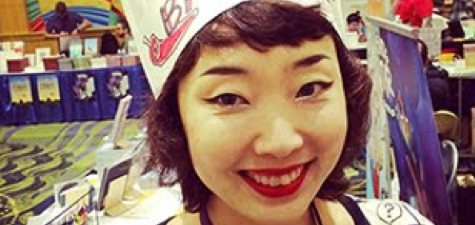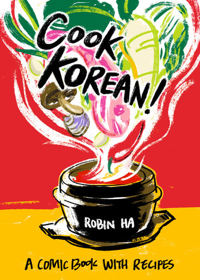
Some people read novels, while others read graphic novels. It is still reading – but a little different. And that difference keeps them engaged and excited.
But what about cookbooks? Pages and pages of writing and photographs can make some people’s heads swim.
In that case, what you need is a graphic cookbook.
Robin Ha to the rescue. Her Cook Korean: A Comic Book with Recipes (Ten Speed 2016) is just what a hungry graphic novel aficionado needs.
 The prologue introduces Robin’s alter ego, Dengki, and describes in cartoon drawing why Robin decided to combine her talent and passion for art with cooking. Her drawings underscore that cooking is fun and not intimidating. She starts with a page of 7 Key Ingredients like Fish Sauce, Red Chile Paste, and Toasted Sesame Oil with their Korean names. Next are pages on the Korean refrigerator, Korean pantry and a Korean Meal Guide with a table laid with the small dishes that make up a typical meal. Finally, she includes a map of Korea with regional foods. The first chapter is on the Korean staple: Kimchi and Pickles. You have to love garlic, ginger, and red chile paste. Robin (or Dengki) walks you through the history of kimchi (chiles have only been available for the last 400 years) and steps to making kimchi. The veggies have a speaking part with little bubbles filled with veggie witticisms. But don’t stop at Easy Kimchi (pp. 26-7), there’s also Radish Cube Kimchi, Cool & Spicy Cucumber pickles (pp. 30-1) with Korean chives and carrots – a fun alternative to Gardiniera. There is even a recipe for Chayote Pickles (pp. 34-5) that’s ready to eat after a few days in the refrigerator. Robin points out that the recipe can pickled other vegetables like asparagus, cauliflower, and broccoli. Then you can use your pickles in Square Cut Kimchi Gazpacho. (pp. 36-7) or Kimchi Pancake (pp. 258-9) Robin shows Dengki’s hands cutting, mixing, and stirring. She draws blenders, pots, jars, and measuring cups. There is a whirlwind of colorful activity on each page.
The prologue introduces Robin’s alter ego, Dengki, and describes in cartoon drawing why Robin decided to combine her talent and passion for art with cooking. Her drawings underscore that cooking is fun and not intimidating. She starts with a page of 7 Key Ingredients like Fish Sauce, Red Chile Paste, and Toasted Sesame Oil with their Korean names. Next are pages on the Korean refrigerator, Korean pantry and a Korean Meal Guide with a table laid with the small dishes that make up a typical meal. Finally, she includes a map of Korea with regional foods. The first chapter is on the Korean staple: Kimchi and Pickles. You have to love garlic, ginger, and red chile paste. Robin (or Dengki) walks you through the history of kimchi (chiles have only been available for the last 400 years) and steps to making kimchi. The veggies have a speaking part with little bubbles filled with veggie witticisms. But don’t stop at Easy Kimchi (pp. 26-7), there’s also Radish Cube Kimchi, Cool & Spicy Cucumber pickles (pp. 30-1) with Korean chives and carrots – a fun alternative to Gardiniera. There is even a recipe for Chayote Pickles (pp. 34-5) that’s ready to eat after a few days in the refrigerator. Robin points out that the recipe can pickled other vegetables like asparagus, cauliflower, and broccoli. Then you can use your pickles in Square Cut Kimchi Gazpacho. (pp. 36-7) or Kimchi Pancake (pp. 258-9) Robin shows Dengki’s hands cutting, mixing, and stirring. She draws blenders, pots, jars, and measuring cups. There is a whirlwind of colorful activity on each page.
There is a chapter on Korean Barbecue, but many of the recipes are vegetarian or vegetable based, with others focused on rice cakes and noodles. The last chapter includes fusion dishes like Chicken Tacos (pp. 268-9):
Mexican food is quite similar to Korean food- both like rice and spicy chile sauces, and wrapped food. I love tacos because you can combine any filling you like in a tortilla, similar to how Koreans eat grilled meat wrapped in lettuce.
She tops the Korean spiced chicken with a kimchi salsa. Her Korean Burgers (pp. 270-1) are topped with kimchi and one of her condiments: Spicy Caviar Mayonnaise, Soy Sesame Mayonnaise, or Sweet & Spicy Ketchup.
Cook Korean is a colorful, engaging, fun cookbook. If you are looking for a gift for someone who likes graphic novels, comics, manga, or anime, then you definitely should take a look – you might even get one for yourself. Forget watching a cooking program – Cooking Korean is far more colorful and fun.
